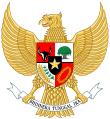
Back Εκλογές στην Ινδονησία Greek Élections en Indonésie French Pemilihan umum di Indonesia ID Pilihan umum ing Indonésia JV Pilihan raya umum di Indonesia Malay

| This article is part of a series on the |
| Politics of Indonesia |
|---|
 |
Elections in Indonesia have taken place since 1955 to elect a legislature. At a national level, Indonesian people did not elect a head of state – the president – until 2004. Since then, the president is elected for a five-year term, as are the 580-member People's Representative Council (Dewan Perwakilan Rakyat, DPR), the 152-seat Regional Representative Council (Dewan Perwakilan Daerah) in 2024 general election, in addition to provincial and municipal legislative councils.
Members of the People's Representative Council are elected by proportional representation from multi-candidate constituencies. Currently, there are 77 constituencies in Indonesia, and each returns 3-10 Members of Parliament based on population. Under Indonesia's multi-party system, no one party has yet been able to secure an outright majority in a democratic election; parties have needed to work together in coalition governments. Members of the Regional Representative Council are elected by single non-transferable vote. There, Indonesia's 34 provinces treated as constituencies and, regardless of the size and population, every province return four senators.
Starting from the 2015 unified local elections, Indonesia started to elect governors and mayors simultaneously on the same date.
The voting age in Indonesia is 17, but anyone who has an ID card (KTP) can vote since persons under 17 who are or were married can get a KTP.[1] Elections are conducted by the General Elections Commission (KPU) and supervised by the General Election Supervisory Agency (Bawaslu); their activities were overseen by Elections Organizer Honorary Council (DKPP).
- ^ Asy'ari, Hakim; Syarifah, Nur (24 October 2022). "Peraturan Komisi Pemilihan Umum Nomor 7 Tahun 2022 tentang Penyusunan Daftar Pemilih dalam Penyelenggaraan Pemilihan Umum dan Sistem Informasi Data Pemilih" [General Election Commission Regulations Number 7 of 2022 about Preparation of Voter List In The Organization of Elections General and Voter Data Information System] (PDF). Jakarta: General Elections Commission. p. 4−11.